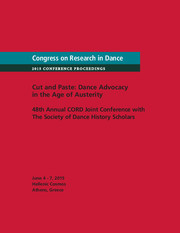No CrossRef data available.
Article contents
Evaluating Methods of Traditional Dances: Case Study in Nihon Buyo
Published online by Cambridge University Press: 04 January 2013
Abstract
This paper proposes two evaluating methods of traditional dances to put traditional dances in school education, taking Nihon Buyo as an example. One is a skill evaluation method using motion capture equipment. Digitized data of movements could provide scientific pedagogy and appraisal in school education. The other is an impression evaluation method using Semantic Differential (SD) method. Impressions that spectators get from Nihon Buyo can be statistically and objectively evaluated. Though traditional dances have various styles, techniques, and representations, these two methods could be applied differently to understand them scientifically and put them in school education in perspective on a global basis.
- Type
- Research Article
- Information
- Copyright
- Copyright © The Author(s) 2009


